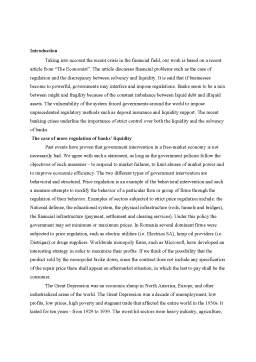Extras din proiect
Introduction
Taking into account the recent crisis in the financial field, our work is based on a recent article from “The Economist”. The article discusses financial problems such as the case of regulation and the discrepancy between solvency and liquidity. It is said that if businesses become to powerful, governments may interfere and impose regulations. Banks seem to be a mix between might and fragility because of the constant imbalance between liquid debt and illiquid assets. The vulnerability of the system forced governments around the world to impose unprecedented regulatory methods such as deposit insurance and liquidity support. The recent banking crises underline the importance of strict control over both the liquidity and the solvency of banks.
The case of more regulation of banks’ liquidity
Past events have proven that government intervention in a free-market economy is not necessarily bad. We agree with such a statement, as long as the government policies follow the objectives of such measures – to respond to market failures, to limit abuses of market power and to improve economic efficiency. The two different types of government intervention are behavioral and structural. Price regulation is an example of the behavioral intervention and such a measure attempts to modify the behavior of a particular firm or group of firms through the regulation of their behavior. Examples of sectors subjected to strict price regulation include: the National defense, the educational system, the physical infrastructure (rods, tunnels and bridges), the financial infrastructure (payment, settlement and clearing services). Under this policy the government may set minimum or maximum prices. In Romania several dominant firms were subjected to price regulation, such as electric utilities (i.e. Electrica SA), lamp oil providers (i.e. Distrigaz) or drugs suppliers. Worldwide monopoly firms, such as Microsoft, have developed an interesting strategy in order to maximize their profits. If we think of the possibility that the product sold by the monopolist broke down, since the contract does not include any specification of the repair price there shall appear an aftermarket situation, in which the last to pay shall be the consumer.
The Great Depression was an economic slump in North America, Europe, and other industrialized areas of the world. The Great Depression was a decade of unemployment, low profits, low prices, high poverty and stagnant trade that affected the entire world in the 1930s. It lasted for ten years - from 1929 to 1939. The worst hit sectors were heavy industry, agriculture, mining and logging. The stock market crash of 1929 initiated the Great Depression in the United States which then spread to every continent. It is a common misconception that the stock market crash of October 1929 was the cause of the Great Depression; in fact, the stock market crash was one of the major causes that led to the Great Depression. False prosperity (overdependence on mass production, consumer spending, advertising high tariff, "invisible hand", real wages increased only 11%), speculation, banking crisis (deposits withdrawn, deflation, 9000 banks fail in 1930), unemployment, trade collapse (foreign countries retaliate with high tariffs, Weimar Republic unable to pay reparations or U.S. banks loans) and republican policy ( laissez faire - the principle that the economy works best if private industry is not regulated and markets are free, balanced budget, trickle down, voluntarism, no use of monetary or fiscal policies) are another reasons that historians and economists have cited as causing the Great Depression. The effects of the Great Depression were profound throughout Europe, though the greatest impact was on Germany (which was struggling to pay reparations imposed by the peace settlements after World War I, suffered to a larger extent than any other major industrial nation; nearly 40 percent of the German workforce was unemployed by 1932), Austria (Austria's bank failed May 1931), Britain, France (here the depression took longer to hit hard because it was less industrialized than the United States, Germany, and Britain; also, because so many French men had died in World War I, the workforce was very small) and Poland (here one out of five men were unemployed and as a result the production fell by some forty per cent).
The American banks were responsible for prolonging the situation. Throughout the 1930s over 9,000 banks failed. Bank deposits were uninsured and thus as banks failed people simply lost their savings. With the stock market crash and the fears of further economic woes, individuals from all classes stopped purchasing items. This led to a reduction in the number of items produced and thus a reduction in the workforce. As people lost their jobs, they were unable to keep up with paying for the items they had bought through installment plans and their goods were repossessed.
Preview document
Conținut arhivă zip
- The Case for More Regulation of Banks' Liquidity
- articol the economist.doc
- referat.doc












